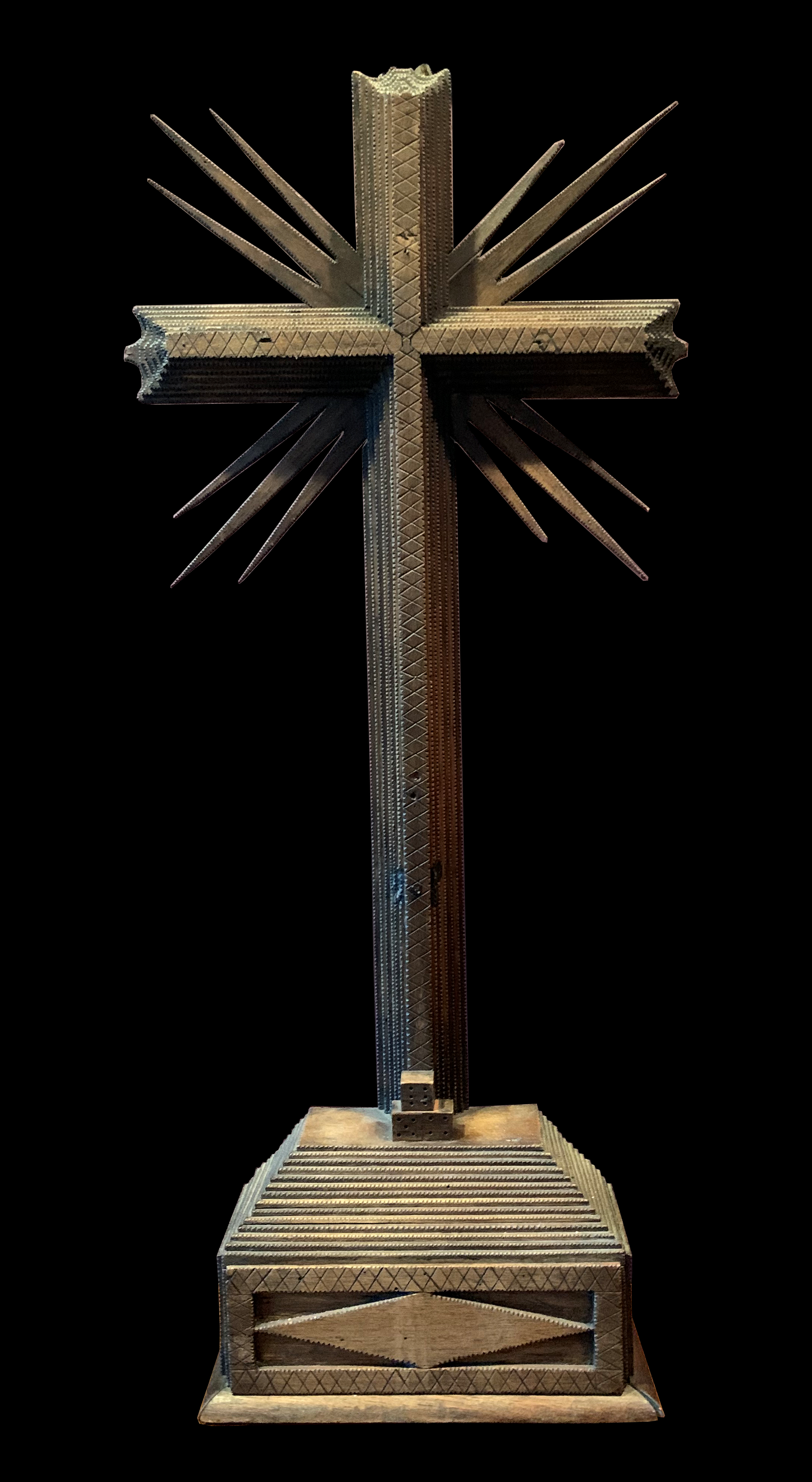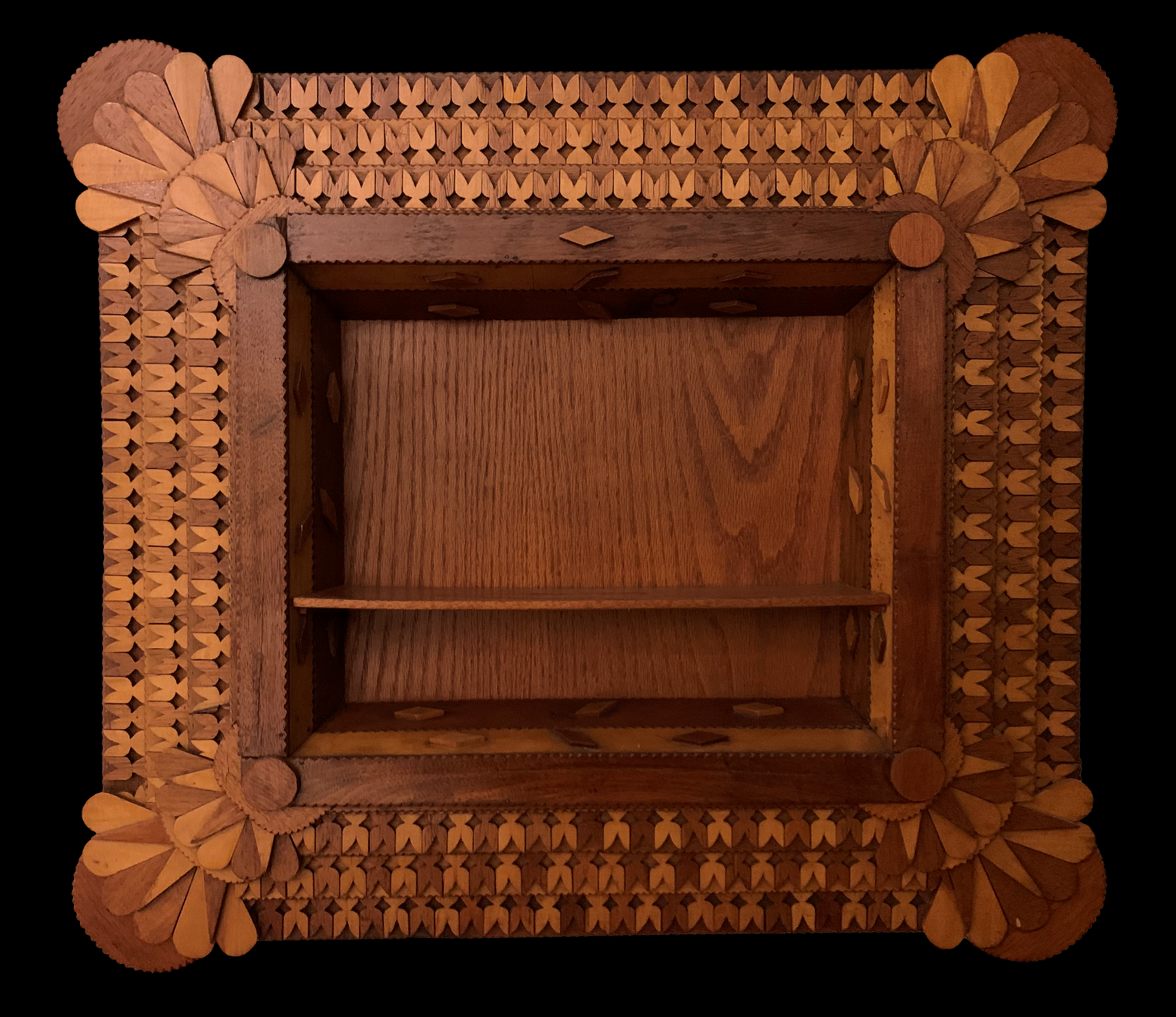Tramp Art
Tramp art defines folk art in its purest sense. It is said that Tramp Art was the work of hobos traveling the countryside and bartering fancifully made boxes and frames for food and lodging. Knowledge was limited on this and was supplemented by hearsay and stories passed from antique dealer to dealer. Though it was popular around 1870 through the 1940s, it started to decline in production. Tramp Art has been clouded in misconceptions and was only identified as an art form in 1959. Helaine Fendelman is best known for bringing Tramp Art to the forefront again with curating a ground breaking exhibition in 1975 at the Museum of American Folk Art. Tramp Art is a woodworking style where small pieces of wood, primarily from discarded cigar boxes and shipping crates, are whittled into layers of geometric patterns with the outside edges of each layer notch-carved. It is a vision of creating art out of society’s discards. The tools used were simple such as a pocketknife, a small saw, and sometimes a file. Tramp art was constructed in a way similar to how a bricklayer or mason would assemble a wall. The artists made their sculptures in a simple and understandable way not defined by the structure or pre-established regimen. They were inspired by nature and more significantly, by their own inner emotions. Tramp art is an expression of an individual’s sense of oneself and one’s surroundings and the ability to transform discarded materials into useful and purposeful art. ⁸
Also included in this category are examples of memory jugs and Trench art. In my collection are WWI artillery shells that have been embossed/etched into the casing. Most are dated 1917-1918 and often include a soldier’s name or a location, for example Champagne, France. Also included are a couple of examples of embroidery therapy during WW1 which was a common practice for rehabilitating soldiers. The examples included are from 1918 and most likely stitched in France.
Tramp Art Train - 12x10x36 - painted fruit crate, wood, and carved figures - electrified for interior viewing
Detail of Tramp Art Train
Tramp box art with Eagle - wood carved with 2 drawers - 15.5x8x9
German box with velvet pin cushion - 1897 - 11x6x6 - wood and chip carving material
Tramp art box with cross and shaking hands (religious) - 1930's - 13x7.5x8 - jewelry style box carved wood
Front view of Tramp art box with cross and shaking hands (religious) - 1930's - 13x7.5x8 - jewelry style box carved wood
Yellow color box with lid and bottom in pyramid shape - 15x9x10 - wood
Bamboo styling - highly ornate with 20's female profile - 1940's - 15.5x13x12 - 2 hidden compartments
Top detail view of Bamboo styling - highly ornate with 20's female profile - 1940's - 15.5x13x12 - 2 hidden compartments
Small grey box with lions and squirrels - 1930's - 7x7x3.5 - light grey and silver with "TN" 2 squirrels
Blonde box with cross in brown on flat top - 1950's - 10x6x5 - pine, matchsticks, varnish
Velvet and dark wood with metal feet - 1920's - 10x6x6.5 - dark wood with velvet inlays
Brown plus metal cupids and decals signed on the inside by Leopold Glatz - 1910 - 10.5x5.5x8
Large box on pedestal - 1930's - 17x13x13 - dark wood in pyramid shape with top
Tramp Art Crucifix Sunburst with dice - carved chipped wood with dice and hidden drawer - 27x12x4
Tramp Art Crucifix Candle holder - 23x17x8 - carved chipped wood
Mirror, triangular shaped framed - 24x14x2.5 - chipped wood
Crown of thorns crucifix - 19.5x8.5x8.5 - carved wood and pot metal crucifx
Tramp art display frame (two tone) with shelf - 23x26 - chipped, carved wood
Sanctuary - 38x19x10 - chip carved, velvet, wallpaper
4 Trench art WW1 shells - average 3x10x4 - brass, copper, engraved
3 Trench art WW1 shells - 3x15 - brass, copper, engraved
WW1 1918 embroidery Courage France, here are my legions
WW1 1918 embroidery - 15x21
Art box - dark wood with 2 Victorian photos - 1900 - 15x15x8 - footed with white knobs and pin cushion
Tramp art red, white and blue mirror - 32x27x3 - mirror, chipped wood, paint
Chip carved wood, mirror with victorian fabric - 33x18
Chip carved wood, paint, varnished mirror - 22x26x2
Memory Vessel Pennslyvania Origin Hand blown Bottle - c.1891 - 12 x 8 - Putty and found objects , bird
Stoneware memory Jug Pennslyvania Origin - c 1900 - 9.5 x 8 - putty and found objects






























